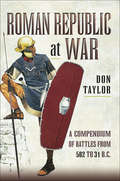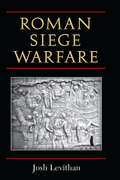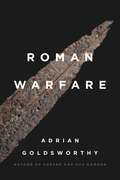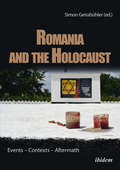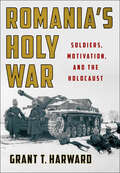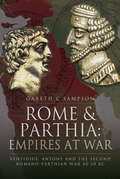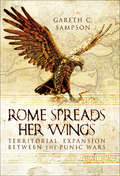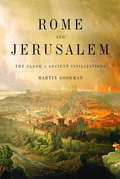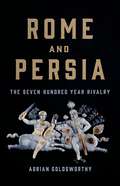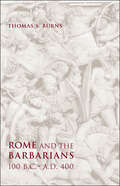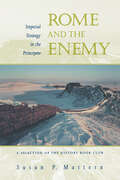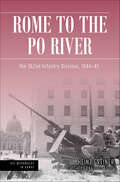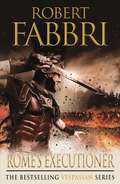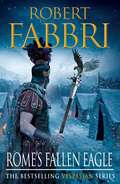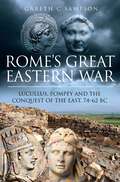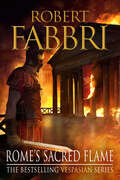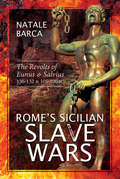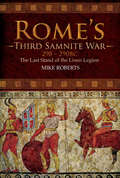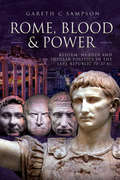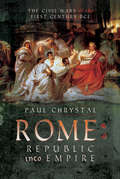- Table View
- List View
Roman Republic at War: A Compendium of Battles from 502 to 31 B.C.
by Don TaylorDescriptions of every significant battle fought by the Roman Republic between 480 and 31 BC—and most of the minor ones too: &“Amazing&” (Books Monthly). The information in each entry of this remarkable book is drawn exclusively from ancient texts in order to offer a brief description of each battle based solely on the information provided by the earliest surviving sources that chronicle the event. This approach provides the reader a concise foundation of information to which they can then confidently apply later scholarly interpretation presented in secondary sources, achieving a more accurate understanding of the most likely battlefield scenario. In writing the battle descriptions, the author has not sought to analyze the evidence contained in the surviving accounts, nor embellish them beyond that which was necessary to provide clarity to the modern reader. He allows the original writers to speak for themselves, presenting the reader with a succinct version of what the ancient chroniclers tell us of these dramatic events. It is an excellent first-stop reference to the many battles of the Roman Republic. &“An indispensable reference guide for any student of the Roman military.&” —The NYMAS Review
Roman Siege Warfare
by Josh LevithanRoman siege warfare had its own structure and customs, and expectations both by the besieged and by the attacking army. Sieges are typically sorted by the techniques and technologies that attackers used, but the more fruitful approach offered in Roman Siege Warfare examines the way a siege follows or diverges from typical narrative and operational plotlines. Author Josh Levithan emphasizes the human elements--morale and motivation--rather than the engineering, and he recaptures the sense of a siege as an event in progress that offers numerous attitudes, methods, and outcomes. Sieges involved a concentration of violent effort in space and the practical challenge posed by a high wall: unlike field battles they were sharply defined in time, in space, and in operational terms. Chapters examine motivation and behavior during a siege and focus on examples from both the Roman Republic and the Empire: Polybius, Livy, Julius Caesar, Flavius Josephus, and Ammianus Marcellinus. Levithan examines the "gadgetary turn," during which writers began to lavish attention on artillery and wall-damaging techniques, fetishizing technology and obscuring the centrality of the assault and of human behavior. This volume speaks to classicists and historians of all stripes. All passages are translated, and references are accessible to nonspecialists. Military historians will also find much of interest in the volume, in its treatment both of Roman military conduct and of wider military practice.
Roman Soldier vs Germanic Warrior
by Peter Dennis Lindsay PowellFrom the annals of Tacitus we get a one-sided vision of the Romano-Germanic wars. More recent scholarship, including Osprey's Teutoburg Forest Campaign book, paints a more balanced picture. Yet, there's still a lot of ground to cover on the subject. The reigns of Augustus and his successor Tiberius saw an epic struggle between the Romans and local peoples for the territory between the Rhine and Elbe rivers in what is now Germany. Following two decades of Roman occupation, Germania Magna erupted into revolt in AD 9 following the loss of the three legions commanded by Publius Quinctilius Varus to the Cheruscan nobleman Arminius and an alliance of Germanic nations in the dense forests of the Teutoburger Wald. The Romans' initial panic subsided as it became clear that Arminius and his allies could not continue the war into Germania Inferior on the western bank of the Rhine, and Imperial troops poured into the region as the Romans decided how best to resolve the situation.In AD 14 Tiberius' adopted son, Germanicus Caesar, quelled a mutiny among Roman forces in the area, then took his men on a quick punitive raid into Germanic territory. In the following year he snatched the wife and father-in-law of Arminius and located the site of the 'Varian Disaster', where he oversaw burial of the bones of Roman dead and erected a cenotaph. In AD 16 Germanicus set out to engage his Cheruscan adversary and defeat him decisively with a view to tipping the balance of power in the region as a prelude to restoring full Roman control over territory between the Rhine and the Elbe. By that summer, the Germanicus had tracked down Arminius to a location on the Weser River in the region of modern-day Minden. An initial engagement - called the battle of Weser River - ended in a draw when a Roman cavalry charge was repulsed by Arminius' own cavalry and Germanicus withdrew his men. Having transferred his force across the river and camped for the night, he laid out a plan for a set-piece battle with his opponent at a place called the Plain of Idistaviso.Idistaviso was the first battle the Romans won against Arminius since Teutoburg. It proved they could beat him. Despite his unique understanding of both Roman and Germanic strategy and tactics, Arminius' failure to anticipate the Roman defence in depth, compounded by dissimilarities in arms and equipment, and confusion on the ground, made this battle particularly vicious and bloody. Better led and disciplined, and with a robust battle strategy, Germanicus' men decisively defeated Arminius'. At the ensuing battle of the Angrivarian Wall the Romans crushed the Germans again.Featuring full-color artwork, specially drawn maps and an array of revealing illustrations depicting weapons, equipment, key locations and personalities, this study offers key insights into the tactics, leadership, combat performance, and subsequent reputations of the Roman soldiers and their Germanic opponents pitched into a series of pivotal actions on the Imperial frontier that would influence Roman/German relations for decades to come.
Roman Warfare (Smithsonian History Of Warfare Ser.)
by Adrian GoldsworthyFrom an award-winning historian of ancient Rome, a concise and comprehensive history of the fighting forces that created the Roman EmpireRoman warfare was relentless in its pursuit of victory. A ruthless approach to combat played a major part in Rome's history, creating an empire that eventually included much of Europe, the Near East and North Africa. What distinguished the Roman army from its opponents was the uncompromising and total destruction of its enemies. Yet this ferocity was combined with a genius for absorbing conquered peoples, creating one of the most enduring empires ever known.In Roman Warfare, celebrated historian Adrian Goldsworthy traces the history of Roman warfare from 753 BC, the traditional date of the founding of Rome by Romulus, to the eventual decline and fall of Roman Empire and attempts to recover Rome and Italy from the "barbarians" in the sixth century AD. It is the indispensable history of the most professional fighting force in ancient history, an army that created an Empire and changed the world.
Romania and the Holocaust: Events – Contexts – Aftermath
by Simon GeissbühlerFrom summer 1941 onwards, Romania actively pursued at its own initiative the mass killing of Jews in the territories it controlled. 1941 saw 13,000 Jewish residents of the Romanian city of Ia?i killed, the extermination of thousands of Jews in Northern Bukovina and Bessarabia by Romanian armed forces and local people, large-scale deportations of Jews to the camps and ghettos of Transnistria, and massacres in and around Odessa. Overall, more than 300,000 Jews of Romanian and Soviet or Ukrainian origin were murdered in Romanian-controlled territories during the Second World War. In this volume, a number of renowned experts shed light on the events, context, and aftermath of this under-researched and lesser-known dimension of the Holocaust. 75 years on, this book gives a much-needed impetus to research on the Holocaust in Romania and Romanian-controlled territories.
Romania's Holy War: Soldiers, Motivation, and the Holocaust (Battlegrounds: Cornell Studies in Military History)
by Grant T. HarwardRomania's Holy War rights the widespread myth that Romania was a reluctant member of the Axis during World War II. In correcting this fallacy, Grant T. Harward shows that, of an estimated 300,000 Jews who perished in Romania and Romanian-occupied Ukraine, more than 64,000 were, in fact, killed by Romanian soldiers. Moreover, the Romanian Army conducted a brutal campaign in German-occupied Ukraine, resulting in the deaths of thousands of Soviet prisoners of war, partisans, and civilians. Investigating why Romanian soldiers fought and committed such atrocities, Harward argues that strong ideology—a cocktail of nationalism, religion, antisemitism, and anticommunism—undergirded their motivation. Romania's Holy War draws on official military records, wartime periodicals, soldiers' diaries and memoirs, subsequent war crimes investigations, and recent interviews with veterans to tell the full story. Harward integrates the Holocaust into the narrative of military operations to show that most soldiers fully supported the wartime dictator, General Ion Antonescu, and his regime's holy war against "Judeo-Bolshevism." The army perpetrated mass reprisals, targeting Jews in liberated Romanian territory; supported the deportation and concentration of Jews in camps or ghettos in Romanian-occupied Soviet territory; and played a key supporting role in SS efforts to exterminate Jews in German-occupied Soviet territory. Harward proves that Romania became Nazi Germany's most important ally in the war against the USSR because its soldiers were highly motivated, thus overturning much of what we thought we knew about this theater of war. Romania's Holy War provides the first complete history of why Romanian soldiers fought on the Eastern Front.
Rome & Parthia: Ventidius, Antony and the Second Romano-Parthian War, 40–20 BC
by Gareth C. SampsonA Roman historian examines the motivation and strategy behind Marc Anthony’s invasion of Parthia and the reasons for its ultimate defeat.In the mid-first century BC, the Roman Empire was rivaled only by the Parthian Empire to the east. The first war between these two ancient superpowers resulted in the total defeat of Rome and the death of Marcus Crassus. When Rome collapsed into Civil War in the 1st century, BC, the Parthians took the opportunity conquer the Middle East and drive Rome back into Europe. What followed was two decades of war which saw victories and defeats on both sides. The Romans were finally able to gain a victory over the Parthians thanks to the great general Publius Ventidius. These victories acted as a springboard for Marc Antony’s plans to conquer the Parthian Empire, which ended in ignominious defeat. In this authoritative history, Gareth Sampson analyses the military campaigns and the various battles between Rome and Parthia. He provides fascinating insight into the war that in many ways defined the Middle East for the next 650 years.
Rome In The Teutoburg Forest
by LCDR James L. VenckusThis paper examines the battle of Teutoburg (9 A.D.), its consequences on the Roman world, and the role cultural misunderstanding played on the tactical, operational, and strategic levels. The Roman commander's cultural misunderstanding of his enemy caused mistakes at the operational and tactical levels, while the Roman Emperor's cultural misunderstanding brought about mistakes at the strategic level and created poor policy decisions following the battle, which affected Rome like no other battle in its history. Chapter 2 examines the consequences of other Roman loses (with much higher casualties) to show how none of them carried the same impact as the Teutoburg loss. They were but temporary "setbacks", while Teutoburg was Rome's first military "defeat" in its history. The Roman direction of conquest into Germania and the image of the pre-Teutoburg Germanic barbarian (an image which changes greatly into an elevated status following the massacre) are also examined. Chapter 3 examines the commanders of both sides and the battle itself. Chapter 4 looks at the significance of this loss. This battle caused Rome to adopt its first permanent defensive boundary and set the first limit of the Roman Empire.
Rome Seizes the Trident: The Defeat of Carthaginian Seapower & the Forging of the Roman Empire
by Marc G. DeSantisSeapower played a greater part in ancient empire building than is often appreciated. The Punic Wars, especially the first, were characterized by massive naval battles. The Romans did not even possess a navy of their own when war broke out between them and the Carthaginians in Sicily in 264 B.C. Prior to that, the Romans had relied upon several South Italian Greek cities to provide ships in the same way as its other allies provided soldiers to serve with the legions. The Romans were nevertheless determined to acquire a navy that could challenge that of Carthage. They used a captured galley as a model, reverse engineered it, and constructed hundreds of copies. The Romans used this new navy to wrench maritime superiority from the Carthaginians, most notably at the Battle of Ecnomus where they prevailed through the use of novel tactics. Although not decisive on its own, Rome's new found naval power was, as Marc De Santis shows, a vital component in their ultimate victory in each of the three Punic Wars.
Rome Spreads Her Wings: Territorial Expansion Between the Punic Wars
by Gareth C. SampsonThe two decades between the end of the First Punic War and the beginning of the Second represent a key period in the development of Romes imperial ambitions, both within Italy and beyond. Within Italy, Rome faced an invasion of Gauls from Northern Italy, which threatened the very existence of the Roman state. This war culminated at the Battle of Telamon and the final Roman victory against the Gauls of Italy, giving Rome control of the peninsula up to the Alps for the first time in her history. Beyond the shores of Italy, Rome acquired her first provinces, in the form of Sardinia and Corsica, established footholds in Sicily and Spain and crossed the Adriatic to establish a presence on the Greek mainland, bringing Rome into the orbit of the Hellenistic World. Yet this period is often treated as nothing more than an intermission between the two better known Punic Wars, with each Roman campaign being made seemingly in anticipation of a further conflict with Carthage. Such a view overlooks two key factors that emerge from these decades: firstly, that Rome faced a far graver threat in the form of the Gauls of Northern Italy than she had faced at the hands of the Carthaginians in the First Punic War; secondly, that the foundations for Romes overseas empire were laid in these very decades. This work seeks to redress the balance and view these wars in their own right, analyse how close Rome came to being defeated in Italy and asses the importance of these decades as a key period in the foundation of Romes future empire.
Rome and Jerusalem: The Clash of Ancient Civilizations
by Martin GoodmanA magisterial history of the titanic struggle between the Roman and Jewish worlds that led to the destruction of Jerusalem.Martin Goodman—equally renowned in Jewish and in Roman studies—examines this conflict, its causes, and its consequences with unprecedented authority and thoroughness. He delineates the incompatibility between the cultural, political, and religious beliefs and practices of the two peoples and explains how Rome's interests were served by a policy of brutality against the Jews. At the same time, Christians began to distance themselves from their origins, becoming increasingly hostile toward Jews as Christian influence spread within the empire. This is the authoritative work of how these two great civilizations collided and how the reverberations are felt to this day.From the Trade Paperback edition.
Rome and Persia: The Seven Hundred Year Rivalry
by Adrian GoldsworthyA &“magnificent&” (Spectator) history of the epic rivalry between the ancient world&’s two great superpowers The Roman empire was like no other. Stretching from the north of Britain to the Sahara, and from the Atlantic coast to the Euphrates, it imposed peace and prosperity on an unprecedented scale. Its only true rival lay in the east, where the Parthian and then Persian empires ruled over great cities and the trade routes to mysterious lands beyond. This was the region Alexander the Great had swept through, creating a dream of glory and conquest that tantalized Greeks and Romans alike. Tracing seven centuries of conflict between Rome and Persia, historian Adrian Goldsworthy shows how these two great powers evolved together. Despite their endless clashes, trade between the empires enriched them both, and a mutual respect prevented both Rome and Persia from permanently destroying the other. Epic in scope, Rome and Persia completely reshapes our understanding of one of the greatest rivalries of world history.
Rome and the Barbarians, 100 B.C.–A.D. 400 (Ancient Society and History)
by Thomas S. BurnsThe barbarians of antiquity, so long a fixture of the public imagination as the savages who sacked and destroyed Rome, emerge in this colorful, richly textured history as a much more complex—and far more interesting—factor in the expansion, and eventual unmaking, of the Roman Empire. Thomas S. Burns marshals an abundance of archeological and literary evidence, as well as three decades of study and experience, to bring forth an unusually far-sighted and wide-ranging account of the relations between Romans and non-Romans along the frontiers of western Europe from the last years of the Republic into late antiquity.Looking at a 500-year time span beginning with early encounters between barbarians and Romans around 100 B.C. and ending with the spread of barbarian settlement in the western Empire around A.D. 400, Burns removes the barbarians from their narrow niche as invaders and conquerors and places them in the broader context of neighbors, (sometimes bitter) friends, and settlers. His nuanced history subtly shows how Rome's relations with the barbarians—and vice versa—slowly but inexorably evolved from general ignorance, hostility, and suspicion toward tolerance, synergy, and integration. What he describes is, in fact, a drawn-out period of acculturation, characterized more by continuity than by change and conflict and leading to the creation of a new Romano-barbarian hybrid society and culture that anticipated the values and traditions of medieval civilization.
Rome and the Barbarians, 100 B.C.–A.D. 400 (Ancient Society and History)
by Thomas S. BurnsThis historical analysis of Roman-Barbarian relations from the Republic into late antiquity offers a striking new perspective on the fall of the Empire.The barbarians of antiquity, often portrayed simply as the savages who destroyed Rome, emerge in this colorful, richly textured history as a much more complex factor in the expansion, and eventual unmaking, of the Roman Empire. Thomas S. Burns marshals an abundance of archeological and literary evidence to bring forth a detailed and wide-ranging account of the relations between Romans and non-Romans along the frontiers of western Europe.Looking at a 500-year time span beginning with early encounters between barbarians and Romans around 100 B.C. and ending with the spread of barbarian settlement in the western Empire, Burns reframes the barbarians as neighbors, friends, and settlers. His nuanced history subtly shows how Rome’s relations with the barbarians slowly evolved from general ignorance, hostility, and suspicion toward tolerance, synergy, and integration. This long period of acculturation led to a new Romano-barbarian hybrid society and culture that anticipated the values and traditions of medieval civilization.
Rome and the Enemy: Imperial Strategy in the Principate
by Susan P. MatternHow did the Romans build and maintain one of the most powerful and stable empires in the history of the world? This illuminating book draws on the literature, especially the historiography, composed by the members of the elite who conducted Roman foreign affairs. From this evidence, Susan P. Mattern reevaluates the roots, motivations, and goals of Roman imperial foreign policy especially as that policy related to warfare. In a major reinterpretation of the sources, Rome and the Enemy shows that concepts of national honor, fierce competition for status, and revenge drove Roman foreign policy, and though different from the highly rationalizing strategies often attributed to the Romans, dictated patterns of response that remained consistent over centuries.Mattern reconstructs the world view of the Roman decision-makers, the emperors, and the elite from which they drew their advisers. She discusses Roman conceptions of geography, strategy, economics, and the influence of traditional Roman values on the conduct of military campaigns. She shows that these leaders were more strongly influenced by a traditional, stereotyped perception of the enemy and a drive to avenge insults to their national honor than by concepts of defensible borders. In fact, the desire to enforce an image of Roman power was a major policy goal behind many of their most brutal and aggressive campaigns.Rome and the Enemy provides a fascinating look into the Roman mind in addition to a compelling reexamination of Roman conceptions of warfare and national honor. The resulting picture creates a new understanding of Rome's long mastery of the Mediterranean world.
Rome to the Po River: The 362nd Infantry Division, 1944–45 (Die Wehrmacht im Kampf)
by Matthias Strohn Heinz Greiner“…this book shines when it comes to understanding the campaigns on a lower level than has normally shown us by authors.” —A Wargamers Needful ThingsIn late 1943, 362. Infanterie-Division was formed around the remnants of 268. Infanterie-Division, which had been disbanded after high casualties on the Eastern Front. It fought at Anzio in early 1944, overrun when the Allied broke through the German lines in April. During its time at Anzio, the division was involved in the Benedicta massacre. The unit was withdrawn to Rome. Facing the Allied advance, it suffered further losses and had to be rebuilt once more. Returning to the front, it then fought until late April 1945, when it surrendered. This account focuses on the efforts of 362. Infanterie-Division to turn back the Allied forces from their advance north in late 1944 and early 1945. Its commander, Heinz Greiner led the division in a series of counterattacks against Allied forces outside Rome that slowed Allied progress. While Greiner did not have access to the unit war diary while writing this account his experience as commander of 362. Infanterie-Division throughout this period means that it offers a unique insight into the battle from the German perspective as well as a thorough account of the reestablishment, training and combat performance of a German division.
Rome's Executioner: Tribune Of Rome, Rome's Executioner, False God Of Rome (Vespasian #2)
by Robert FabbriA hero is forged in battle and a legend is born in this second installment in the Vespasian seriesThracia, AD30: Even after four years of military service at the edge of the Roman world, Vespasian can't escape the tumultuous politics of an Empire on the brink of disintegration. His patrons in Rome have charged him with the clandestine extraction of an old enemy from a fortress on the banks of the Danube before it falls to the Roman legion besieging it. Vespasian's mission is the key move in a deadly struggle for the right to rule the Roman Empire. The man he has been ordered to seize could be the witness that will destroy Sejanus, commander of the Praetorian Guard, and ruler of the Empire in all but name. Before he completes his mission, Vespasian will face ambush in snowbound mountains, pirates on the high seas, and Sejanus's spies all around him. But by far the greatest danger lies at the rotten heart of the Empire, at the nightmarish court of Tiberius, Emperor of Rome and debauched, paranoid madman.
Rome's Fallen Eagle (Vespasian #4)
by Robert FabbriVespasian's fourth adventure—can he escape his own Emperor's wrath?Caligula has been assassinated and the Praetorian Guard have proclaimed Claudius Emperor—but his position is precarious. His three freedmen, Narcissus, Pallas, and Callistus, must find a way to manufacture a quick victory for Claudius—but how? Pallas has the answer: retrieve the Eagle of the Seventeenth, lost in Germania nearly 40 years before. Who but Vespasian could lead a dangerous mission into the gloomy forests of Germania? Accompanied by a small band of cavalry, Vespasian and his brother try to pick up the trail of the Eagle, but they are tailed by hunters who pick off men each night and leave the corpses in their path. Someone is determined to sabotage Vespasian's mission. In search of the Eagle and the truth, pursued by barbarians, Vespasian will battle his way to the shores of Britannia.
Rome's Great Eastern War: Lucullus, Pompey and the Conquest of the East, 74–62 BC
by Gareth C. SampsonThis military history of Ancient Rome analyses the empire&’s revitalized push against rising enemies to the East. In the century since Rome&’s defeat of the Seleucid Empire in the 180s BC, the East was dominated by the rise of new empires: Parthia, Armenia, and Pontus, each vying to recreate the glories of the Persian Empire. By the 80s BC, the Pontic Empire of Mithridates had grown so bold that it invaded and annexed the whole of Rome&’s eastern empire and occupied Greece itself. But as Rome emerged from the devastating effects of the First Civil War, a new breed of general emerged with it, eager to re-assert Roman military dominance and carve out a fresh empire in the east. In Rome&’s Great Eastern War, Gareth C. Sampson analyses the military campaigns and battles between a revitalized Rome and the various powers of the eastern Mediterranean hinterland. He demonstrates how this series of conflicts ultimately heralded a new phase in Roman imperial expansion and reshaped the ancient East.
Rome's Sacred Flame: Sunday Post's Best Reads Of The Year 2018 (Vespasian #8)
by Robert FabbriVespasian has been made Governor of Africa. Nero, Rome's increasingly unpredictable Emperor, orders him to journey with his most trusted men to a far-flung empire in Africa to free 200 Roman citizens who have been enslaved by a desert kingdom. Vespasian arrives at the city to negotiate their emancipation, hoping to return to Rome a hero and find himself back in favor with Nero. But when Vespasian reaches the city, he discovers a slave population on the edge of revolt. With no army to keep the population in check, it isn't long before tensions spill over into bloody chaos. Vespasian must escape the city with all 200 Roman citizens and make their way across a barren desert, battling thirst and exhaustion, with a hoard of rebels at their backs. It's a desperate race for survival, with twists and turns aplenty. Meanwhile, back in Rome, Nero's extravagance goes unchecked. All of Rome's elite fear for their lives as Nero's closest allies run amok. Can anyone stop the Emperor before Rome devours itself? And if Nero is to be toppled, who will be the one to put his head in the lion's mouth?
Rome's Sicilian Slave Wars: The Revolts of Eunus & Salvius, 136–132 & 105–100 BC
by Natale BarcaA study of the two Late Republic slave revolts, exploring their social context, the nature of slavery at the time, and the causes of the conflicts.In 136 BC, in Sicily (which was then a Roman province), some four hundred slaves of Syrian origin rebelled against their masters and seized the city of Henna with much bloodshed. Their leader, a fortune-teller named Eunus, was declared king (taking the Syrian royal name Antiochus), and tens of thousands of runaway slaves as well as poor native Sicilians soon flocked to join his fledgling kingdom. Antiochus’ ambition was to drive the Romans from the whole of Sicily. The Romans responded with characteristic unwillingness and relentlessness, leading to years of brutal warfare and suppression. Antiochus’ “Kingdom of the Western Syrians” was extinguished by 132, but his agenda was revived in 105 BC when rebelling slaves proclaimed Salvius as King Tryphon, with similarly bitter and bloody results.Natale Barca narrates and analyses these events in unprecedented detail, with thorough research into the surviving ancient sources. The author also reveals the long-term legacy of the slaves’ defiance, contributing to the crises that led to the seismic Social War and setting a precedent for the more-famous rebellion of Spartacus in 73–71 BC.Praise for Rome’s Sicilian Slave Wars“An interesting read, and a good account of these large scale and very significant slave uprisings, giving us an idea of what the rebels were attempting to achieve, the methods they chose, and each revolt managed to survive for so long before being crushed.” —History of War
Rome's Third Samnite War, 298–290 BC: The Last Stand of the Linen Legion
by Mike RobertsA compelling account of alliances, animosities, and ancient warfare in central Italy.The Third Samnite War was a crucial episode in the early history of Rome. Upon its outcome rested mastery of central Italy, and the independent survival of both Rome and the Samnites. Determined to resist aggressive Roman expansion, the Samnites forged a powerful alliance with the Senones (a tribe of Italian Gauls), Etruscans, and Umbrians. The result was eight years of hard campaigning, brutal sieges, and bitter battles that stretched Rome to the limit. The desperate nature of the struggle is illustrated by the ritual self-sacrifice (devotio) by the Roman consul Publius Decimus Mus at the Battle of Sentinum (295 BC), which restored the resolve of the wavering Roman troops, and by the Samnite Linen Legion at the Battle of Aquilonia (393 BC), each man of which was bound by a sacred oath to conquer or die on the battlefield.Mike Roberts, who has travelled the Italian landscape upon which these events played out, mines the sources—which are more reliable, he argues, than for Rome’s previous wars—to produce a compelling narrative of this momentous conflict.
Rome, Blood & Politics: Reform, Murder and Popular Politics in the Late Republic, 133–70 BC
by Gareth C. SampsonThis in-depth chronicle examines the series of political upheavals that led to division, violence, and civil war in the ancient Roman Republic. The last century of the Roman Republic saw the consensus of the ruling elite shattered by a series of high-profile politicians who proposed political or social reform programs, many of which culminated in acts of bloodshed on the streets of Rome itself. This began in 133 BC with the military recruitment reforms of Tiberius Gracchus, which saw him and his supporters lynched by a mob of angry Senators. Gracchus&’s grim example was followed by a series of radical politicians, each with their own agenda that challenged the status quo of the Senatorial elite. Each met a violent response from elements of the ruling order, leading to murder and even battles on the streets of Rome. These bloody political clashes paralyzed the Roman state, eventually leading to its collapse. Covering the period 133–70 BC, this volume analyzes each of the key reformers, what they were trying to achieve and how they met their end, narrating the long decline of the Roman Republic into anarchy and civil war.
Rome, Blood & Power: Reform, Murder and Popular Politics in the Late Republic 70–27 BC
by Gareth C. Sampson&“Capture[s] the essence of the struggle within Rome for reform and power and dominance . . . a page turner of a book . . . that offers fresh insight.&” —Firetrench Following the First Civil War the Roman Republic was able to rebuild itself and restore stability. Yet the problems which had plagued the previous seventy years of the Republic, of political reform being met with violence and bloodshed, had not been resolved and once again resumed. Men such as Catiline and Clodius took up the mantle of reform which saw Rome paralyzed with domestic conflict and ultimately carnage and murder. In the search for stability, the Roman system produced a series of military dynasts; men such as Pompey, Crassus and Caesar. Ultimately this led to the Republic&’s collapse into a second and third civil war and the end of the old Republican system. In its place was the Principate, a new Republic founded on the promise of peace and security at home and an end to the decades of bloodshed. Gareth Sampson analyses the various reforming politicians, their policies and opponents and the conflicts that resulted. He charts the Republic&’s collapse into further civil wars and the new system that rose from the ashes. &“[Sampson] has obviously done a huge amount of research, and yet managed to turn what could be a dry subject into an interesting tale of men battling for control. Far more exciting than Game of Thrones, and with added gladiators!&” —Army Rumour Service (ARRSE)
Rome: The Civil Wars of the First Century BCE
by Paul ChrystalRome: Republic into Empire looks at the political and social reasons why Rome repeatedly descended into civil war in the early 1st century BCE and why these conflicts continued for most of the century; it describes and examines the protagonists, their military skills, their political aims and the battles they fought and lost; it discusses the consequences of each battle and how the final conflict led to a seismic change in the Roman political system with the establishment of an autocratic empire. This is not just another arid chronological list of battles, their winners and their losers. Using a wide range of literary and archaeological evidence, Paul Chrystal offers a rare insight into the wars, battles and politics of this most turbulent and consequential of ancient world centuries; in so doing, it gives us an eloquent and exciting political, military and social history of ancient Rome during one of its most cataclysmic and crucial periods, explaining why and how the civil wars led to the establishment of one of the greatest empires the world has known.
